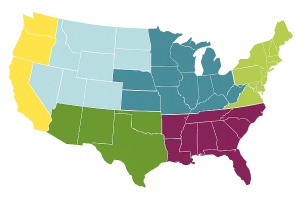How To Naturalize Daffodils & Best Bulbs That Multiply and Spread
Posted By American Meadows Content Team on Jul 26, 2017 · Revised on Oct 3, 2025

Knowing your location helps us recommend plants that will thrive in your climate, based on your Growing Zone.
Posted By American Meadows Content Team on Jul 26, 2017 · Revised on Oct 3, 2025
Do you have little space or time for gardening, but crave early spring color to brighten your yard? Are you the kind of gardener who leans more towards natural and relaxed than formal and manicured? If you’ve answered yes to these questions, Daffodils are for you!
Naturalizing is a technique used by gardeners and landscapers to establish plants outside of typical garden beds, encouraging them to multiply and spread. Daffodils are lovely in beds and borders, but when allowed to naturalize, multiply, spread, they can flourish beyond traditional garden boundaries. Daffodils are especially rewarding -- they offer some of the earliest spring flowers, with bold, cheerful blooms. Plus, there’s little to no work involved for the gardener after planting, and they can thrive and multiply for decades.
This guide will tell you how to choose the best site for Daffodils, which Daffodil bulbs are best for naturalizing and spreading, and give you expert tips for planning and planting your bulbs. Plus, learn more about the benefits of planting Daffodils with trees and vegetable gardens. Let's dig in!
When choosing a site to naturalize Daffodils, you want:
Many of the older tried-and-tested cultivars of Daffodils can bloom for at least 30 years, and even up to 50 years when left to their own devices. When mixing with surrounding plants, the smaller varieties may be better. These bulbs from American Meadows are the best-known for their naturalizing superpowers:
These especially popular varieties are known to naturalize well because they form drifts and can make seeds and baby bulbs.
Plant a mix of bulbs to extend your bloom time and add dynamic visual interest to your planting! Below are recommendations for early-, mid-, and late-spring Daffodils. Remember, when shopping for bulbs, you can use our "Bloom Time" filter to sort bulbs by bloom time.
Trees and shrubs can provide an ideal backdrop for Daffodil flowers. Daffodils also have several qualities that make them ideal companions for most deciduous tree and shrub species.
A tree guild is a small community of plants that encircles a tree to provide a relatively self-sufficient support system. Most deciduous trees, including fruit and nut trees, will benefit more from being surrounded by living plants than a stark circle of mulch that must be replaced each spring.
A tree guild works best with a variety of plants that will flower at different times during the growing season. Each plant in a tree guild has a role, such as fertilizing, attracting beneficial insects, providing a mulch source, or repelling pests.
For example, an apple tree guild might include these plants in harmony:
It's a great idea to plant Daffodils around trees, and there are several ways Daffodils contribute to tree guilds to keep trees healthier year-round.
A note about evergreens: While daffodils can offer a nice contrast to evergreen tree trunks, they should be planted some distance away from the base; daffodils cannot tolerate the poor drainage created by spring shade and the constant dripping of evergreen foliage when the weather is wet.
Flowers add beauty and interest to a vegetable garden, and they can be beneficial to your harvest. Daffodils are toxic if eaten by critters, and the plants and bulbs have natural defenses like bitter sap that make them unappetizing to animals like squirrels, chipmunks, and voles. Planting Daffodils along the borders of vegetable beds will help deter animals that might snack on your plants. The above-ground flowers and foliage of daffodils discourage deer and other browsers, and the below-ground bulbs discourage gophers, rabbits, groundhogs, and other diggers.
Vegetable garden tip: Daffodils are not edible, so we recommend planting any onions and their relatives away from Daffodils, so that there is no chance for mistaken identity. Plus, onions and Alliums are also unappetizing to critters, so they can serve as a line of defense in the garden as well.